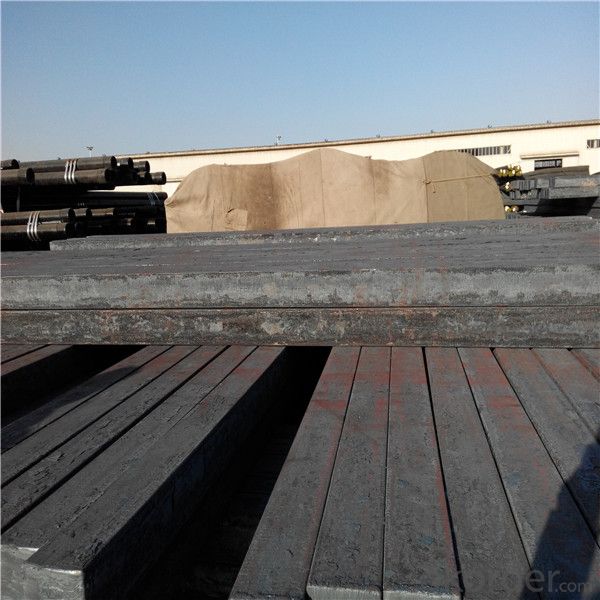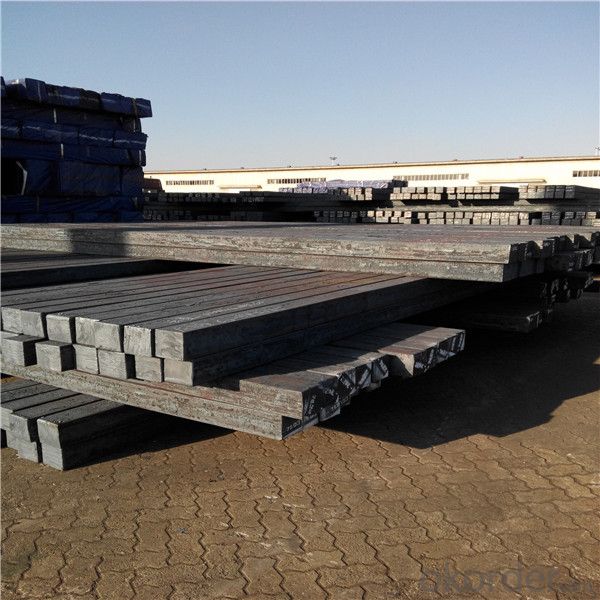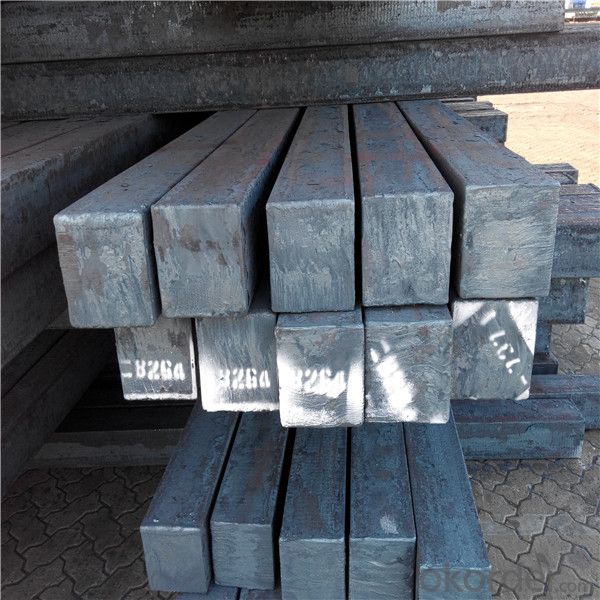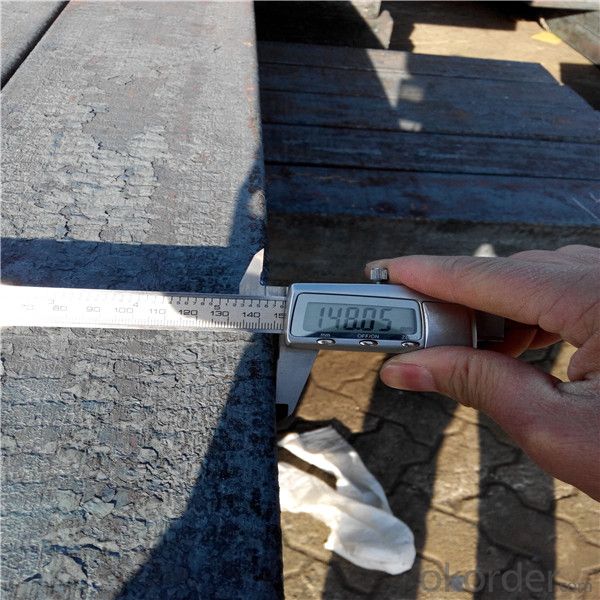Square Billets for steel products material
- Loading Port:
- China main port
- Payment Terms:
- TT OR LC
- Min Order Qty:
- 10000 m.t.
- Supply Capability:
- 14980 m.t./month
OKorder Service Pledge
OKorder Financial Service
You Might Also Like
Item specifice
Steel billet
(ingot) by cogging or breakdown of semifinished products, is the raw material of all kinds of steel mill.
Billet section of square, round, flat, rectangular and abnormity of several kinds of, mainly related to the
shape of rolled products.
Rectangular billet continuous casting billet and mainly general carbon steel, low carbon low silicon cold-rolled material, high quality carbon structural steel, high strength low alloy steel, special steel, etc.
The billet is mainly divided into two kinds from the shape:
Slab: cross section width and height of the ratio of the larger, mainly used for rolling plate.
Gade:
Standard | C(%) | Mn(%) | S(%) | P(%) | Si(%) |
Q195 | ≤0.12 | ≤0.50 | ≤0.040 | ≤0.035 | ≤0.30 |
Q235 | ≤0.20 | ≤1.40 | ≤0.045 | ≤0.045 | ≤0.35 |
Q275 | ≤0.22 | ≤1.50 | ≤0.045 | ≤0.045 | ≤0.35 |
20MnSi | 0.17-0.25 | 1.2-1.6 | ≤ 0.050 | ≤ 0.050 | 0.40-0.80 |
3SP | 0.14-0.22 | 0.40-0.85 | ≤ 0.050 | ≤ 0.040 | 0.05-0.15 |
5SP | 0.28-0.37 | 0.50-1.00 | ≤ 0.050 | ≤ 0.040 | 0.15-0.30 |




Our service :
We have a plant and professional team to provide our best service, from the start of production until the
loading into the vessel, we have a complete quality follow up procedure, to assure our products arrives to the customer with satisfaction. Welcome new and old customers
to contact us for future business relationships! We will give you a surpise price.
Packing :
Within 30 days
1.Standard export package
2.In bundles with steel strips
3.As the requirements of the customers
FAQ:
Q: What is payment terms?
A: FOB 30% T/T IN ADVANCE AS DEPOSIT AND 70% T/T BEFORE SHIPMENT
CIF and CFR 30% T/T IN ADVANCE AS DEPOSIT AND 70% T/T AS THE COPY OF B/L OR L/C AT SIGHT
Q:How to guarantee the quality of the products?
A:We have established the international advanced quality management system,every link from raw material
to final product we have strict quality test;We resolutely put an end to unqualified products flowing into the market.
At the same time, we will provide necessary follow-up service assurance.
Q:How long can we receive the product after purchase?
A :In the purchase of product within three working days, We will arrange the factory delivery as soon as possible.
The pecific time of receiving is related to the state and position of customers.
- Q:How do steel billets compare to other forms of raw steel material?
- Steel billets possess unique advantages when compared to other forms of steel. Their exceptional strength and durability are well-known. They are manufactured using a meticulously controlled process that ensures uniform composition and consistent grain structure, resulting in superior mechanical properties. Consequently, steel billets are highly suitable for industries requiring robust and dependable steel, such as construction, automotive, and manufacturing. Additionally, steel billets offer remarkable machinability. Their uniform shape and size facilitate easy handling and processing, thereby reducing waste and improving production efficiency. This proves especially advantageous for manufacturers utilizing precision machining techniques to create intricate and complex components. Another benefit of steel billets lies in their versatility. They can be forged, rolled, or extruded into various shapes and sizes, allowing for customization according to specific requirements. This adaptability renders steel billets suitable for an extensive range of applications, ranging from structural beams and bars to pipes and rods. Moreover, steel billets boast a relatively low carbon content, making them more ductile compared to other forms of raw steel material. This enhanced ductility enables simpler shaping and forming, making steel billets particularly appropriate for hot working processes like forging and rolling. In summary, steel billets offer numerous advantages over other forms of raw steel material. Their high strength, excellent machinability, versatility, and ductility make them the preferred choice for many industries. Whether it is for structural purposes or the manufacturing of complex components, steel billets possess the necessary properties and flexibility to meet a wide range of requirements.
- Q:What are the common sizes and dimensions of steel billets?
- Steel billets are produced through continuous casting or hot rolling methods and are semi-finished products. The industry and intended use of the billets determine their sizes and dimensions. While there are common sizes and dimensions used in various applications, they can vary. The size range for steel billets is typically between 100mm and 150mm square. These billets are usually around 6 meters long, but this may differ based on customer needs or the manufacturing process. Round steel billets with diameters ranging from 100mm to 200mm are also commonly produced. The weight of steel billets can range from a few hundred kilograms to several metric tons. The length, cross-sectional area, and density of the steel used determine the weight. Most steel billets fall within the 1 to 5 metric tons range. It is important to understand that these sizes and dimensions can differ among manufacturers, and different industries may have specific requirements. For instance, the automotive industry may require larger or smaller billets based on the parts they produce. In conclusion, steel billets typically have sizes and dimensions between 100mm and 150mm square, with lengths of around 6 meters. Round billets can have diameters ranging from 100mm to 200mm. The weight of a steel billet can vary from a few hundred kilograms to several metric tons. However, it is crucial to consider that these measurements can vary depending on the industry and customer requirements.
- Q:What are the different surface treatments for improved dimensional accuracy in steel billets?
- To enhance dimensional accuracy in steel billets, various surface treatments can be utilized. These treatments have the objectives of reducing surface imperfections, improving surface finish, and minimizing dimensional variations. Some commonly employed surface treatments for achieving improved dimensional accuracy in steel billets include: 1. Shot blasting: By forcefully propelling abrasive particles onto the billet's surface, shot blasting effectively eliminates dirt, scale, and surface contaminants. This results in a smoother and cleaner surface, thereby eliminating potential dimensional variations caused by surface irregularities. 2. Peeling: In this machining process, a cutting tool is used to remove a thin layer of material from the billet's surface. Peeling helps eliminate surface defects and imperfections, leading to enhanced dimensional accuracy. Additionally, peeling can improve the billet's surface finish. 3. Grinding: Material removal from the billet's surface is achieved through the use of an abrasive wheel or belt in the grinding process. This treatment effectively eliminates surface irregularities like high spots or scratches, contributing to improved dimensional accuracy. Furthermore, grinding provides a smoother and more uniform surface finish. 4. Turning: Using a cutting tool, turning involves the removal of material from the billet's surface. This treatment enables the achievement of precise dimensions and surface finish. Additionally, turning can enhance the billet's concentricity and straightness. 5. Polishing: Polishing entails the use of abrasive materials or compounds to create a smooth and reflective surface on the billet. By eliminating surface imperfections such as scratches or blemishes, polishing contributes to improved dimensional accuracy and surface finish. It is important to consider that the choice of surface treatment may vary depending on specific requirements and desired outcomes. Manufacturers often employ a combination of these treatments to attain optimal dimensional accuracy in steel billets.
- Q:What are the potential applications of steel billets in the defense sector?
- Due to their strength, durability, and versatility, steel billets have numerous potential applications in the defense sector. Here are several examples: 1. Armored Vehicles: Steel billets can be utilized to manufacture the hulls and components of armored vehicles, offering improved protection against ballistic threats and explosive devices. Their high strength and toughness make them suitable for enduring extreme conditions and impacts on the battlefield. 2. Weapon Systems: Steel billets can be incorporated into the production of various weapon systems, such as artillery guns, tanks, and missile launchers. These components require materials capable of withstanding high pressures, heat, and mechanical stresses, all of which steel billets can provide. 3. Defense Infrastructure: Steel billets can be employed in the construction of defense infrastructure, including military bases, bunkers, and fortifications. Their high strength and resistance to corrosion make them suitable for enduring environmental and physical challenges. 4. Naval Applications: Steel billets are crucial in the manufacturing of naval vessels, such as submarines, destroyers, and aircraft carriers. The ability of steel billets to withstand the harsh conditions of the marine environment, including corrosion and pressure, makes them an ideal choice for constructing these vessels. 5. Personal Protective Equipment (PPE): Steel billets can be used to produce body armor, helmets, and other protective gear for military personnel. The exceptional strength and impact resistance of steel billets offer enhanced protection against bullets, shrapnel, and other potential threats on the battlefield. 6. Military Infrastructure: Steel billets can be utilized in the construction of bridges, runways, and other critical military infrastructure. Their high load-bearing capacity and durability ensure the longevity and reliability of these structures, thereby supporting military operations. Overall, steel billets have diverse and crucial potential applications in the defense sector. Their properties make them an invaluable material for various defense applications, ensuring the protection of personnel, equipment, and infrastructure in challenging operational environments.
- Q:What is the role of steel billets in the manufacturing of fasteners?
- Steel billets play a crucial role in the manufacturing of fasteners as they serve as the raw material from which fasteners are produced. These billets are heated, molded, and shaped into various forms such as bolts, screws, and nails. The high strength and durability of steel make it an ideal material for fasteners, ensuring that they can withstand the loads and stresses they are subjected to in various applications.
- Q:What are the main challenges in the storage of steel billets?
- The main challenges in the storage of steel billets include maintaining proper environmental conditions, managing space efficiently, ensuring safety measures, preventing corrosion, and minimizing material damage. Firstly, the storage area should be maintained at a controlled temperature and humidity to prevent the steel billets from being exposed to extreme weather conditions, which could lead to rusting, oxidation, or other forms of corrosion. Adequate ventilation is also necessary to prevent the buildup of moisture that could affect the quality of the billets. Secondly, managing space efficiently is crucial in steel billet storage. Billets are often stored in large quantities, so proper organization and stacking methods must be employed to maximize the storage capacity and facilitate easy access to individual billets when needed. Implementing effective inventory management systems can help prevent unnecessary handling and potential damage. Safety measures are another significant challenge in steel billet storage. Due to their heavy weight and potential for sharp edges, it is essential to ensure proper handling and storage procedures to avoid accidents or injuries. Adequate training for personnel and the use of appropriate lifting equipment are necessary to maintain a safe working environment. Corrosion prevention is a critical concern in steel billet storage. Applying protective coatings, such as oil or rust inhibitors, can help shield the billets from moisture and prevent oxidation. Regular inspections and maintenance routines are also necessary to identify and address any signs of corrosion promptly. Lastly, minimizing material damage is crucial in steel billet storage. Proper handling techniques, such as avoiding dropping or dragging the billets, should be followed to prevent deformation or surface damage. Using suitable packaging or padding materials during transportation and storage can also help protect the billets from scratches or other physical impacts. In conclusion, the main challenges in the storage of steel billets revolve around maintaining proper environmental conditions, efficient space management, ensuring safety measures, preventing corrosion, and minimizing material damage. By addressing these challenges effectively, the longevity and quality of the steel billets can be preserved, resulting in enhanced operational efficiency and customer satisfaction.
- Q:How do steel billets contribute to the manufacturing of sports equipment?
- The manufacturing of sports equipment benefits greatly from the use of steel billets. Firstly, steel billets serve as the primary material for the production of steel bars and rods. These bars and rods are then utilized to create the framework and structure of sports equipment, including golf clubs, tennis rackets, and hockey sticks. The exceptional strength and durability of steel make it the perfect material for these applications, as it can withstand the intense impact forces and stresses that occur during sports activities. Furthermore, steel billets are also employed in the manufacturing of various components for sports equipment, such as weights, dumbbells, and barbells. These components necessitate a material with high density that can handle heavy loads, and steel provides the necessary strength and stability. Additionally, steel billets find use in the production of accessories for sports equipment, such as ball bearings, springs, and fasteners. Despite their small size, these components play a vital role in the overall performance and functionality of sports equipment. Steel's exceptional resistance to corrosion and its ability to endure extreme conditions make it the preferred choice, ensuring long-lasting and reliable performance. Moreover, steel billets enable the production of high-quality and precision-made parts for sports equipment. Steel's malleability and formability allow it to be shaped into various intricate designs and configurations, guaranteeing that sports equipment meets the specific requirements of athletes and performs optimally. In conclusion, steel billets are a crucial element in the manufacturing of sports equipment. Their strength, durability, versatility, and formability make them the ideal material for producing frames, components, and accessories that enhance the performance and longevity of sports equipment.
- Q:What are the different types of steel billet casting defects?
- There are several different types of steel billet casting defects that can occur during the casting process. These defects can have varying degrees of severity and can impact the quality and performance of the final product. Some of the most common types of steel billet casting defects include: 1. Shrinkage: Shrinkage defects occur when there is inadequate feeding of liquid metal into the solidifying billet. This can result in voids or cavities within the billet, leading to reduced strength and potential failure under stress. 2. Porosity: Porosity defects are characterized by the presence of small gas bubbles or voids within the billet. These defects can weaken the material, reduce its density, and impair its performance in terms of mechanical properties such as tensile strength and ductility. 3. Inclusions: Inclusions are foreign substances that become trapped within the billet during the casting process. These can include non-metallic particles, oxides, or impurities. Inclusions can negatively impact the mechanical properties, such as reducing ductility and increasing brittleness. 4. Surface defects: Surface defects can occur during the casting process and can include issues such as cracks, scabs, or uneven surfaces. These defects can affect the appearance of the billet and may also impact its structural integrity. 5. Segregation: Segregation defects occur when there is an uneven distribution of alloying elements within the billet. This can result in areas of varying composition, which can lead to inconsistencies in mechanical properties and reduced overall performance. 6. Hot tears: Hot tears are cracks that occur in the billet during solidification due to thermal stresses. These defects can weaken the material and result in reduced strength and failure under stress. 7. Misruns: Misruns occur when the liquid metal does not completely fill the mold cavity, resulting in an incomplete billet. This defect can lead to reduced dimensions, poor surface finish, and compromised mechanical properties. It is important to identify and address these steel billet casting defects to ensure the production of high-quality and reliable steel products. Various techniques such as proper mold design, controlling casting parameters, and process optimization can be employed to minimize these defects and improve the overall quality of the billet.
- Q:Billet heating furnace prices?
- Billet heating furnace as non-standard series equipment, the price is not very fixed. Equipment is different, the price is not the same, in general, you need to find a few better units within the family to do the program offer, according to the program and quote contrast.
- Q:How are steel billets used in the production of forgings?
- Steel billets are an essential component in the production of forgings. They serve as the initial raw material that undergoes a series of processes to transform into the desired forged product. Firstly, the steel billets are heated to a specific temperature to make them more malleable and easier to work with. This process is known as preheating and is crucial as it allows for easier shaping and deformation during the forging process. Next, the heated steel billets are placed into a forging press or hammer, where they are subjected to immense pressure and force. This pressure causes the billets to deform and take on the desired shape. The forging press applies compressive forces to the billets, while the hammer strikes them repeatedly to achieve the desired shape. During the forging process, the steel billets undergo plastic deformation, meaning they change shape without breaking. This deformation allows for the elimination of any internal defects or inconsistencies within the billet, resulting in a stronger and more reliable final forged product. Once the desired shape is achieved, the forged product is cooled down, either through air cooling or quenching, to stabilize its structure and enhance its mechanical properties. This cooling process helps to increase the strength and hardness of the forged product. In summary, steel billets play a crucial role in the production of forgings. They are heated, shaped under immense pressure, and then cooled to create the final forged product. The use of steel billets in the forging process enables the production of durable, high-quality forged products with superior strength and reliability.
1. Manufacturer Overview |
|
|---|---|
| Location | |
| Year Established | |
| Annual Output Value | |
| Main Markets | |
| Company Certifications | |
2. Manufacturer Certificates |
|
|---|---|
| a) Certification Name | |
| Range | |
| Reference | |
| Validity Period | |
3. Manufacturer Capability |
|
|---|---|
| a)Trade Capacity | |
| Nearest Port | |
| Export Percentage | |
| No.of Employees in Trade Department | |
| Language Spoken: | |
| b)Factory Information | |
| Factory Size: | |
| No. of Production Lines | |
| Contract Manufacturing | |
| Product Price Range | |
Send your message to us
Square Billets for steel products material
- Loading Port:
- China main port
- Payment Terms:
- TT OR LC
- Min Order Qty:
- 10000 m.t.
- Supply Capability:
- 14980 m.t./month
OKorder Service Pledge
OKorder Financial Service
Similar products
New products
Hot products
Hot Searches
Related keywords





























